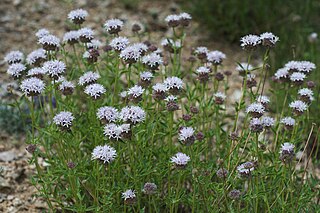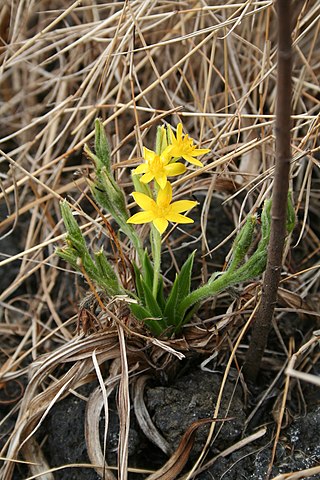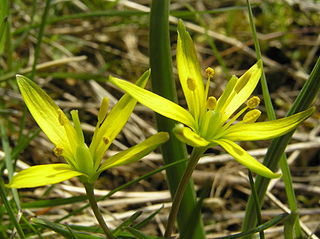
Ranunculus repens, the creeping buttercup, is a flowering plant in the buttercup family Ranunculaceae, native to Europe, Asia and northwestern Africa. It is also called creeping crowfoot and sitfast.

Vicia cracca, is a species of flowering plant in the pea and bean family Fabaceae. It is native to Europe and Asia. It occurs on other continents as an introduced species, including North America, where it is a common weed. It often occurs in disturbed habitats, including old fields and roadside ditches.

Gagea is a large genus of spring flowers in the lily family. It is found primarily in Eurasia with a few species extending into North Africa and one species in North America.

Gagea lutea, known as the yellow star-of-Bethlehem, is a Eurasian flowering plant species in the family Liliaceae. It is widespread in central Europe with scattered populations in Great Britain, Spain, and Norway to Siberia and Japan.

Gagea bohemica, the early star-of-Bethlehem or Radnor lily, is a European and Mediterranean species of flowering plant in the lily family. It is sometimes referred to as the Welsh Star-of-Bethlehem.

Vicia villosa, known as the hairy vetch, fodder vetch or winter vetch, is a plant native to some of Europe and western Asia. It is a legume, grown as a forage crop, fodder crop, cover crop, and green manure. Although non-native, it occurs in all US states and is considered invasive by some states, such as Alaska, Florida, Georgia, Kansas, Michigan, Minnesota, Nebraska, Oregon, and Washington state — as well as in Japan and some parts of Europe where it is not native. It is also found in most Canadian provinces.

Monardella odoratissima is a perennial flowering plant. It is a member of the mint family Lamiaceae. It has the minty odor characteristic of this family. In 2020, Monardella villosa was included in M. odoratissima. As of April 2024, acceptance of the inclusion varies.

Hypoxis is a genus of flowering plants of the family Hypoxidaceae. The genus has an "almost cosmopolitan" distribution, occurring in Africa, the Americas, Asia, and Australia. Europe lacks native species. Most species are in the Southern Hemisphere, especially in southern Africa. Common names for the genus include star-grass, star lily, yellow stars, African potato, and stars. The genus is the largest of the Hypoxidaceae and has its centre of variation in South Africa, where it occurs in open undisturbed grasslands. The name Hypoxis was taken over by Linnaeus in 1759 from a name coined by Paul Reneaulme in 1611 for a superficially similar species of Gagea and meaning "a little sour", referring to the taste of that plant's leaves.

Vicia hirsuta is a species of flowering plant in the pea and bean family Fabaceae.

Gagea minima, known as the least gagea, is a Eurasian species of plants in the lily family.

Gagea pratensis, called the yellow star-of-Bethlehem, is a European and Mediterranean plant species in the lily family. It is widespread across much of Europe as well as Turkey and Morocco. It was first described to science by Persoon in 1794.

Veronica scutellata is a species of flowering plant in the plantain family known by the common names marsh speedwell, skullcap speedwell, and grassleaf speedwell. It is native to temperate Asia, Europe, northern Africa, and northern North America in a variety of wet habitats.

Thapsia villosa, commonly known as the villous deadly carrot, is a species of poisonous herbaceous plants in the genus Thapsia. It grows to about 70 to 190 cm in height. It has pinnate hairy leaves with sheath-like petioles. The flowers are yellow in color and borne on compound umbels. They develop into fruits with four wings characteristic of the genus. It is native to southwestern Europe and northwestern Africa surrounding the Mediterranean Sea. The plant was used extensively for traditional medicine since around the 3rd century BC.

Gagea liotardii is a Eurasian and North African species of plants in the lily family. It is a bulb-forming perennial up to 15 cm tall. Flowers are generally bright yellow to yellow-green. Its native range stretches from Spain and Morocco to Mongolia.
Baron Friedrich August Marschall von Bieberstein was an early explorer of the flora and archeology of the southern portion of Imperial Russia, including the Caucasus and Novorossiya. He compiled the first comprehensive flora catalogue of the Crimeo-Caucasian region.

Gagea peduncularis is a Mediterranean plant species in the family Liliaceae. It is native to Italy (Apulia), Greece, the Balkans, Turkey, Cyprus, and Libya.
Gagea ramulosa is a Eurasian and North African plant species in the lily family. It is native to France, Sardinia, Sicily, Greece, Turkey, Libya, Ukraine, European Russia, Caucasus, Syria, Lebanon, Iraq, Iran, and Afghanistan. Some authors consider this to be the same species as G. dubia, but the World Checklist does have it listed as a distinct species.

Heterotheca villosa, commonly known as the hairy goldenaster, is a species of flowering plant in the family Asteraceae found in central and western North America.
Polygonum patulum, called tree hogweed, is a species of flowering plant in the knotweed family. It is native to the Mediterranean region, eastern Europe, the Caucasus, Siberia, Central Asia, Mongolia, and the Province of Xinjiang in northwestern China. It has also become sparingly naturalized in scattered locations in Australia and North America.

Fatoua villosa is an annual herb in the Moraceae (mulberry) family. Common names include mulberry weed, crabweed, or hairy crabweed in English,kuwakusa in Japanese, and shuǐ shémá (水蛇麻) or xiǎo shémá (小蛇麻) in Mandarin. It is native to Eastern Asia, some Pacific islands, and parts of Australia, including in two Australian states, the Bismarck Archipelago, China, Indonesia, Japan, Korea, New Guinea, the Philippines, the Solomon Islands, Taiwan, Thailand and Vietnam. It has become an invasive species in the United States where it grows in disturbed areas such as flowerbeds, greenhouses, and agricultural fields.

















